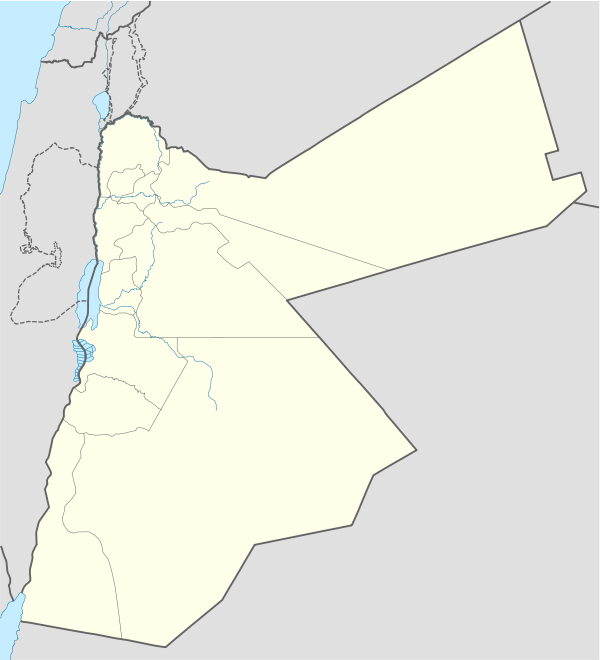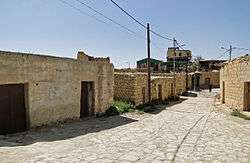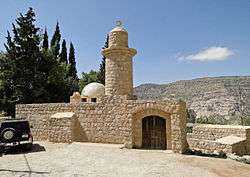Tafilah
Tafilah (Arabic: الطفيلة), also spelled Tafila, is a town with a population of 27559 people in southern Jordan, located 183 kilometers (114 mi) southwest of Amman. It is the capital of Tafilah Governorate. It is well known for having green gardens which contain olive and fig trees, and grape-vines. Tafilah was first built by the Edomites and was called Tophel.
Tafilah الطفيلة | |
|---|---|
City | |
 Seal | |
 Tafilah | |
| Coordinates: 30°50′24″N 35°36′0″E | |
| Country | Jordan |
| Province | Tafilah Governorate |
| Founded | 1100 B.C. |
| Municipality established | 1914 |
| Government | |
| • Type | Municipality |
| • Mayor | Khalid Huneifat |
| Area | |
| • City | 18.518 km2 (7.150 sq mi) |
| • Metro | 38.771 km2 (14.970 sq mi) |
| Elevation | 940 m (3,080 ft) |
| Population (2015)[1] | |
| • City | 27,559 |
| Time zone | GMT +2 |
| • Summer (DST) | +3 |
| Area code(s) | +(962)3 |
| Website | http://www.tafila.jo |
There are more than 360 natural springs in the at-Tafilah area, including the natural reservoir of Dana and hot natural springs at Afra and Burbeita. There are two phosphate and cement mines in at-Tafilah which are one of the country's main income sources.
History
As with other parts of the Levant, signs of habitation in Tafilah Governorate have been found dating from the Palaeolithic periods.



In 1984 a team of archeologists from the University of Arizona discovered stone tools estimated at 90,000 years old in caves in Ain Defla and Hessa. Although no human remains could ever be found dating from that era, the discoveries of prehistoric tools supplied scientists with much information about human civilization stages in the Levant
The oldest known civilization to establish a kingdom on Tafilah soils was that of Edom, and Tafilah lies on the ruins of the Edomite city of Tophel. The capital of Edom was at Busairah 23 km to the south of Tafilah. The Edomites often allied with their neighbors in Moab. Tafilah was then annexed to the Nabatean kingdom who had their capital in Petra. Following the Roman invasion, it was ruled by the Ghassanids, under Rome's authority.
Tafilah then came under Muslim rule, but was for a brief period of time under Crusader rule.
Role in Arab Revolt against the Ottoman Empire (Battle of Tafileh)
During the Arab Revolt, Tafilah was captured after a three-prong attack: an attack on Jurf al-Darwish Station by Sherif Nasir, an attack on Shoubak by Sherif Abdul Mayin, and an attack up the Wadi Araba by Sherif Mastur. On 25 Jan. 1918, forces under T.E. Lawrence, Jaafar Pasha, and Prince Zeid bin Hussein repulsed a counter-attack of 1000 Turkish soldiers led by Hamid Fakhri Pasha, in an attempt to retake Tafilah. Only 50 Turks survived the retreat, while 250 were taken prisoner.[2][3]
Modern era
In 1961 there were 4,506 inhabitants in Tafila.[4]
Education
There is one university in Tafilah, Tafila Technical University. Founded in 1986 as a university college, it expanded to a university in 2005. The university as of the academic year 2009/2010 includes six colleges.[5]
Districts
The city of Tafilah is organized into six districts:
- Al Ees (منطقة العيص)
- Al Baqee' (منطقة البقيع)
- Wadi Zaid (منطقة وادي زيد)
- Aimah (منطقة عيمه)
- Al Hussein (منطقة الحسين )
- Ain Al Baidha (منطقة العين البيضاء)
- Al Mansoura (منطقه المنصوره)
Economy
Although Tafilah Governorate is rich in history, having been the site of the ancient kingdom of Edom, it has one of the lowest numbers of tourists in Jordan. This is due to the fact that Tafilah is off the beaten track; Jordan's main highways do not pass through or nearby the city. The two main highways connecting north to south Jordan are the Dead Sea Highway (Highway 65) and the Desert Highway (Highway 15). To go to Tafilah from the Desert Highway, one must take Highway 60 west at Jurf Al Darawish.
However, Tafilah Governorate is rich in natural resources. Reserves in the governorate are estimated at one million tons of copper and half a million tons of manganese, while phosphate mining is one of the main industries in the governorate.
The towns in Tafilah governorate are mostly located at elevations exceeding 1000m above sea level. In the year 2008 there was a total area of 42.210 km2 of fruit and olive farms in Tafilah Governorate of which more than 31 km2 were olive farms. In the tourism section, Tafilah depends mostly on domestic tourists who visit the hot water springs and the natural reserves in the governorate.
See also
References
- "The General Census - 2015" (PDF). Department of Population Statistics.
- Faulkner, Neil (2016). Lawrence of Arabia's War: The Arabs, the British and the Remaking of the Middle East in WWI. New Haven: Yale University Press. p. 372-377. ISBN 9780300226393.
- Lawrence, T.E. (1935). Seven Pillars of Wisdom. Garden City: Doubleday, Doran & Company, Inc. pp. 470-483.
- Government of Jordan, Department of Statistics, 1964, pp. 6, 13
- Tafila Technical University
Bibliography
- Government of Jordan, Department of Statistics (1964). First Census of Population and Housing. Volume I: Final Tables; General Characteristics of the Population (PDF).